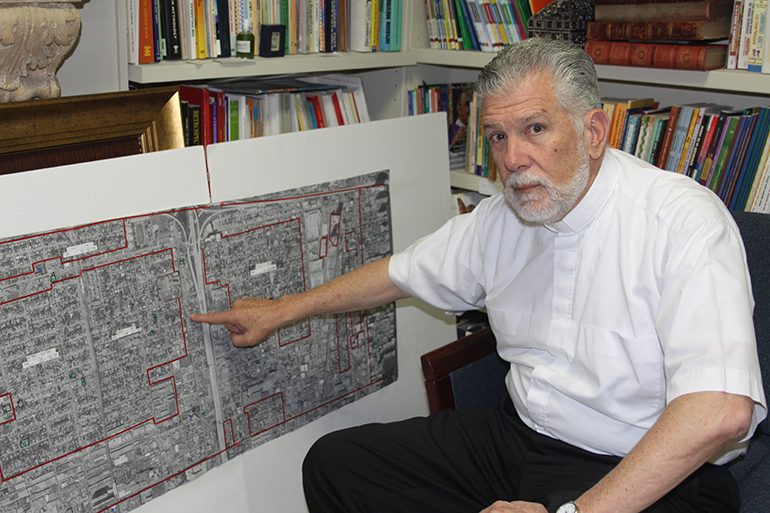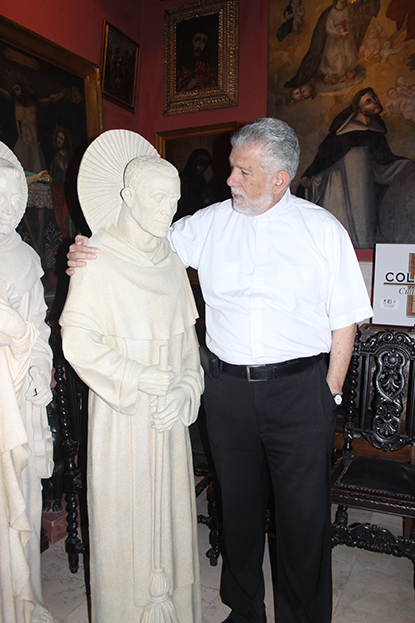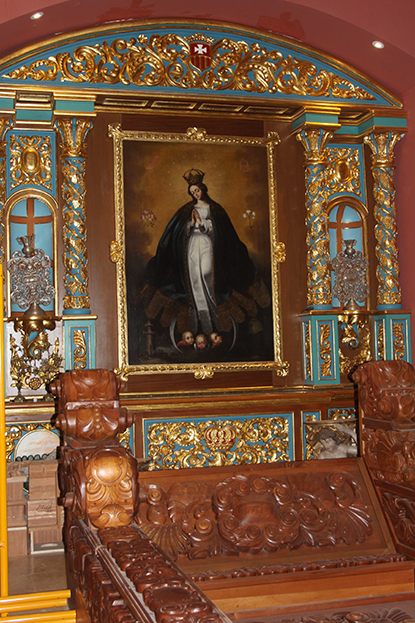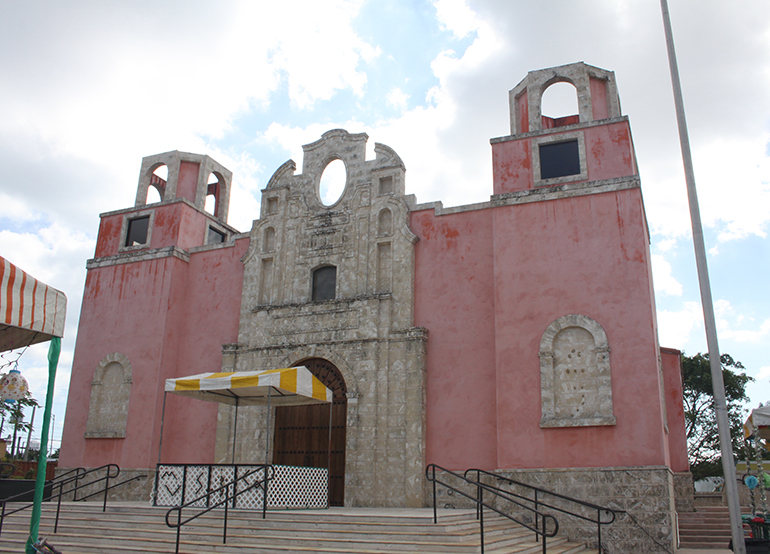By Rocio Granados - La Voz Catolica

Photographer: ROCIO GRANADOS | LVC
Father José Luis Menéndez, pastor of Corpus Christi points out the location of the Mother Church on the map that shows the areas in Miami encompassed by the parish.

Photographer: ROCIO GRANADOS | LVC
Father Jose Luis Menendez poses with an image of Our Lady of Mercy, patroness of the church-museum on the grounds of Corpus Christi Parish that bears her name. The painting is in the Cuzco style that dates to Spanish colonial times in Peru and will be placed in the church's main altar.
MIAMI | At Corpus Christi Parish, 1 plus 5 plus 75 all add up to 1: an overriding mission of evangelization.
One mother church, founded Dec. 12, 1941: Check.
Five outlying missions, serving predominantly Hispanic immigrants: Check.
Seventy-five years of evangelization: Check.
“For me, there’s no other reason for a parish (to exist) other than to evangelize,” said Father Jose Luis Menendez, the church’s pastor. “Throughout these 75 years, we have a community that remembers what it was, is grateful for those who built it, but is answering the needs of the present and preparing for the future.”
Back in 1941, when all of Florida belonged to the single Diocese of St. Augustine, Archbishop Joseph P. Hurley founded Corpus Christi for the purpose of evangelizing Miami � a small city undergoing swift growth at the start of the Second World War.
At the time, Gesu was the church in the heart of downtown Miami. Corpus Christi was located in an area known as Allapattah, northwest of downtown, and populated by Irish and Italian-Americans.
In 1965, the neighborhood was broken up by the construction of I-95, and later again by State Road 112. As a result, the white population moved out and waves of Hispanic immigrants began moving in � especially Cuban exiles in the 1960s and ‘70s, lured by the preponderance of garment factories. Immigrants from the Dominican Republic and Central America arrived in the decades that followed.
Mirtha Bianchi remembers those days. Corpus Christi was the first parish she attended after arriving here from Cuba in 1962. Eventually, she and many of the other Cubans moved away; in Bianchi’s case, to Little Flower in Coral Gables, where her children also attended school.
But Bianchi returned to Corpus Christi for good 20 years ago, lured by the work of its parishioners and priests. She belongs to a group called Friends of Corpus Christi, made up of people who do not live within the parish boundaries but support it economically.
“I feel very proud to belong to the parish and be able to help. Its members are very dedicated and always deserve our help in fulfilling their mission,” she said.
At the end of the 1980s, when Father Menendez was named pastor, he saw the need to establish small communities within the parish boundaries, which run from N.W. 32nd Avenue in the west to Biscayne Bay in the east, and from N.W. 20th Street in the south to N.W. 54th Street in the north. At the same time, he sent volunteers and priests from the parish out into the neighborhoods to evangelize.
“We did what Pope Francis has popularized, to go out to the peripheries and seek out those who were not coming to church,” Father Menendez said.
In doing so they discovered that Corpus Christi was an amalgamation of neighborhoods separated by railroad tracks and the highways, which impeded access to the parish church. The people also were very poor, generally possessing only one car which the father used to get to work while the mother or grandmother stayed home with the children.

Photographer: ROCIO GRANADOS | LVC
Father Jose Luis Menendez poses with the statue of the Peruvian saint St. Martin of Porres, which will be placed in the entry of the church-museum. “With my friend St. Martin of Porres”, says Father Menendez while he asks for his help to finish the church. “In Spain he was know as Fray broom”, he adds.

Photographer: ROCIO GRANADOS | LVC
Our Lady of the Immaculate, belongs to the Cuzco School, arisen in Peru during the Colonial period. At the bottom, part of the roof made of carved cedar wood yet to be placed.
Creating missions
In order to evangelize those neighborhoods “where the people were not going to come to us, we created small centers for celebration,” Father Menendez explained, in three different areas: Wynwood,
He began celebrating Masses in shopping centers, a public school, a center for the elderly, and even a shoe store.
“On Saturdays and Sundays we would go hear confessions and celebrate Mass in those areas,” said Msgr. Oscar Castañeda, who served as parochial vicar at Corpus Christi in those days. He is back in residence now while working as a chaplain at nearby Jackson Memorial Hospital.
The faithful in the neighborhoods organized themselves into small communities and, with the support of their mother church, built mission churches.
All of them are small but designed in the classic style, with a bell tower and an attractive name. They did not call them chapels, as in Latin America.
“From the beginning, we wanted to name them missions, because they have a mission to fulfill in those barrios,” Father Menendez said. “We are not one parish, we are six missions, six sending-forths, six mandates to evangelize that area.”
San Juan Bautista was the first mission, founded in the Wynwood neighborhood and dedicated to the patron saint of Puerto Rico. Then came Nuestra Señora de Altagracia, in the heart of the Dominican community in Allapattah. It shares the grounds with Radio Paz, the archdiocesan radio station. The third mission, San Francisco y Santa Clara, is in Edgewater, in the midst of a predominantly Central American community. The fourth is La Milagrosa, located at 1860 N.W. 19 Terrace, whose population also is mainly Puerto Rican.
In 2009, when St. Robert Bellarmine Parish was merged into Corpus Christi, it became the fifth mission, located at the extreme western edge of the parish boundaries.
Open to people’s needs
Creating the missions enabled Corpus Christi to open itself “to the needs of our people, not only because of the difficulties they had in getting here, but also because people like to celebrate the liturgy with their own rhythms and songs,” said Claretian Sister Carmen Alvarez. “I think it was the people’s needs that compelled us to go out.”
Sister Carmen has spent the past 40 years at Corpus Christi, heading up the ministries of catechesis � with 500 students enrolled � as well as the RCIA and mission choirs. When the parish school was open, she also directed the religious education of its students.
In time, Corpus Christi has evolved, along with its neighborhoods.
“Before, to speak of Biscayne Boulevard meant speaking about drugs and prostitution. Wynwood was crime-ridden, Allapattah was poor, and the best part was in the west, where St. Robert Bellarmine was. Now it’s all reversed. Edgewater or Biscayne North is full of skyscrapers, Wynwood is called Midtown or the Art District,” Father Menendez said.
Most of the population continues to be Hispanic, but some areas of Edgewater now have young people, second-generation Hispanics, Americans, and above all South Americans who speak English. The income levels are higher.
Thinking about their needs, San Francisco y Santa Clara Mission began celebrating Sunday Mass in English at the beginning of December. The Tridentine Latin Mass which was celebrated there moved to La Milagrosa.
Apart from the missions, the entire Corpus Christi community works together on activities such as the parish carnival and devotional feasts, especially processions.
Processions
When devotion to Spain’s “la Macarena” virgin began to spread in 1998, “there were only three of us who wore the Spanish-style mantilla in the procession,” Bianchi said. “Now it’s more than 20 women. It was something we were able to do and others began joining in. They understood why we wanted to maintain the tradition. It’s a way of evangelizing, processing
Another devotion that is quite ingrained in Corpus Christi is “el Señor de
One of the accomplishments of the parish as a whole is La Merced Church, formerly known as Museo Peru (the Peruvian Museum). Although it originated with Peruvian parishioners, support for its construction came from all the other communities.
Located on the grounds of Corpus Christi proper, at 3220 N.W. Seventh Ave., the colonial-style structure houses “the largest collection of colonial art in the United States. And when it’s finished we will have to most beautiful baroque colonial church in the U.S.,” Father Menendez said.
Construction on the church began 11 years ago, and approximately $1.5 million worth of work remains to be done. The structure is complete but the main altar still needs to be gold-plated. Some of the side chapels also are being built out of hand-carved Cedar.
For Father Menendez, the most valuable aspect of La Merced “is the love with which it’s being done. Everything else is material.”
For Msgr. Castañeda, Corpus Christi’s greatest accomplishment has been “to reach people who did not know the church; to reach those who are not evangelized or have fallen away.”
The parish celebrated that reality with a

Photographer: ROCIO GRANADOS | LVC
Front of the church-museum La Merced built with the collaboration of all communities of Corpus Christi Parrish.

